 |
|

|
 |
TABLE of CONTENTS
 |
MnDOT meets the public at the ‘Great Minnesota Get-Back Together’ |

A MnDOT volunteer takes a photo of two Minnesota State Fair attendees visiting MnDOT’s booth and seeing “Plowy McPlowface” on Aug. 30. Plowy is one of eight snowplows named as part of this year’s “Name a Snowplow” contest. MnDOT’s booth is outside, on Cosgrove Street across from the Education Building. Nearly 100 employees have volunteered to work at the booth through the fair’s 12-day run from Aug. 26 to Sept. 6. Photo by Rich Kemp. |
| |
|

|
 |
TABLE of CONTENTS
 |
From scope to slope: How District 4 incorporated anti-drifting measures into its Hwy 12 road design |
By Emma Olson, District 4 Public Affairs
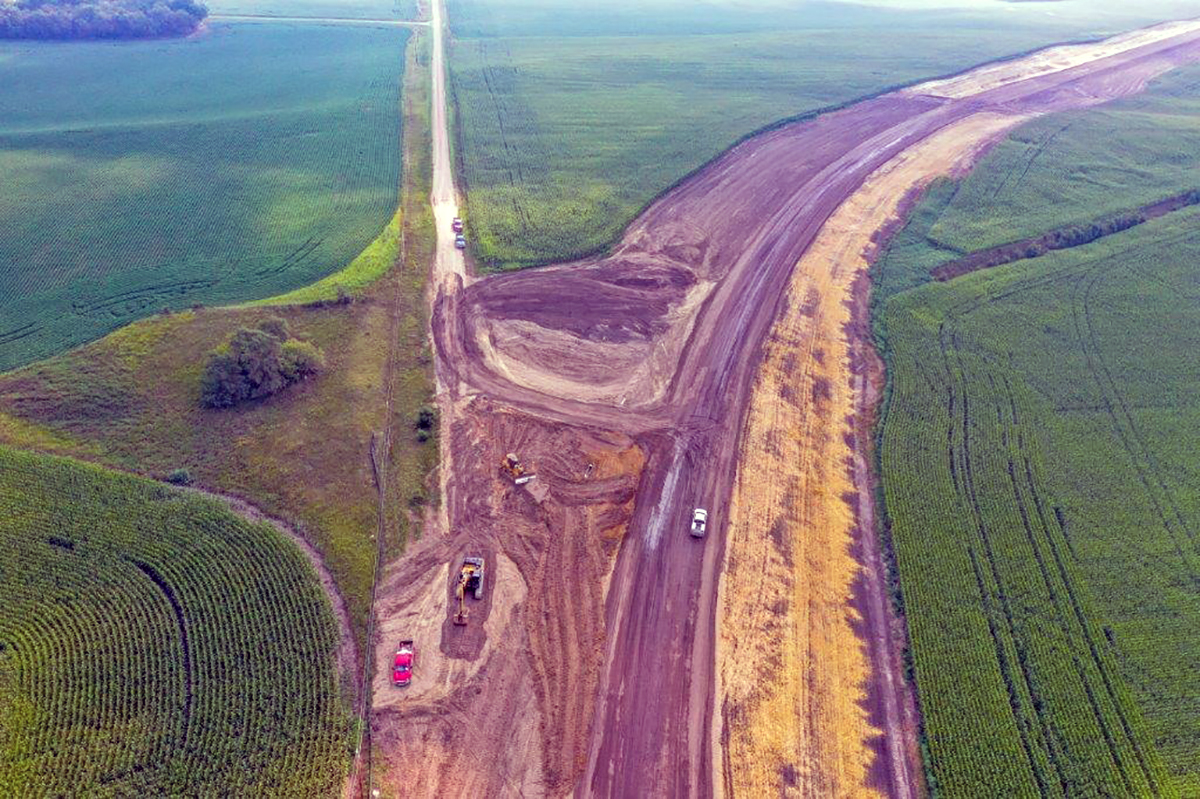
Crews relocated a township road and realigned several curves on Hwy 12 as part of the 2021 road construction. They also increased the ditch-bottom width to allow for improved snow storage in the area. Photo by MnDOT Aeronautics. |
For years, Hwy 12 between Ortonville and Hwy 59 has been a blizzard’s paradise.
A $20 million project to widen shoulders, replace culverts and add anti-snowdrift features is aiming to change that. As of the end of August, the grading and culvert work are halfway done, and crews have completed 11 miles of paving. The project is scheduled to wrap up in October.
Narrow shoulders and wide-open fields often lead to dangerous driving conditions during snow events. This poses a constant challenge for MnDOT snowplow operators, who try their best to keep the road open and assist stranded motorists while simultaneously battling large drifts and reduced visibility.
The clean up after the storm usually isn’t much fun either.
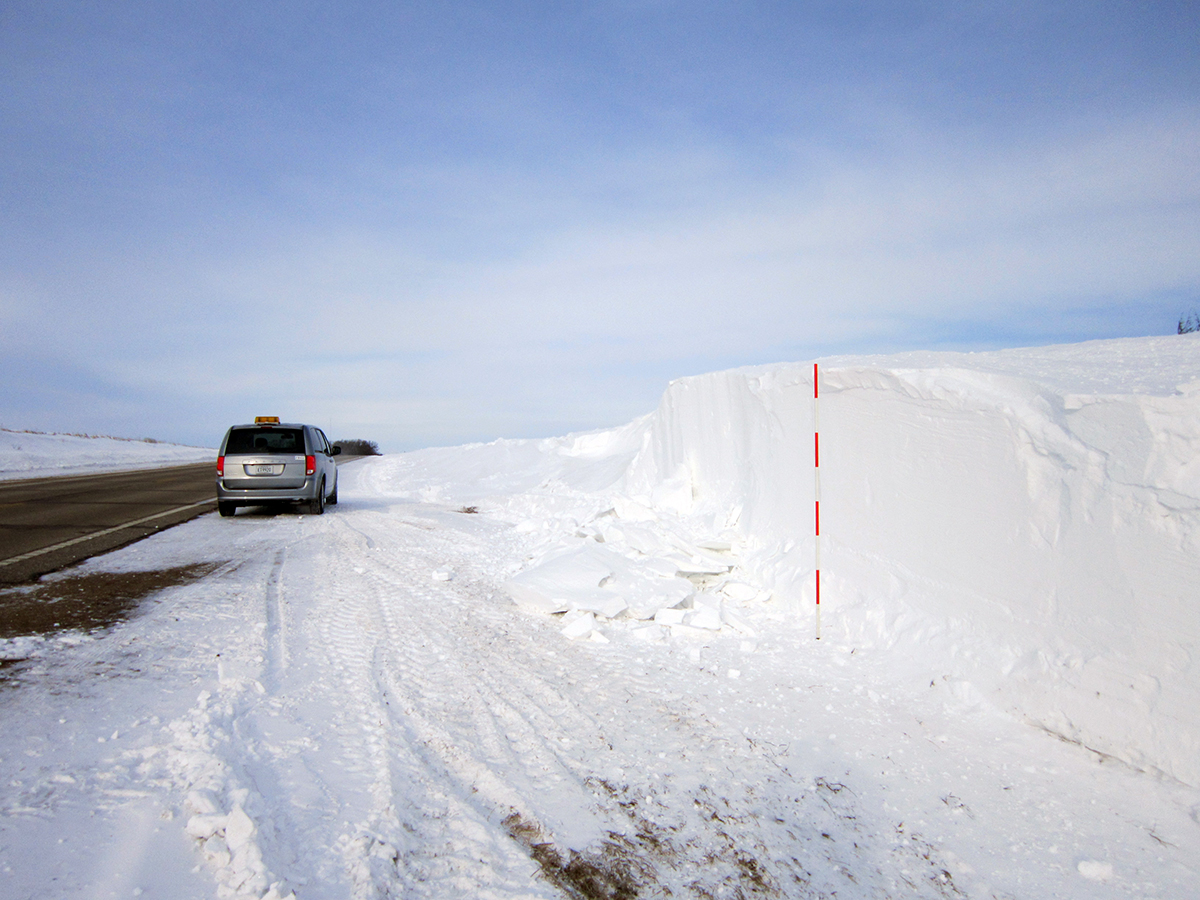
An 8-foot snow drift on Hwy 12 was opened up by MnDOT’s snow blowers in March 2019. This was the largest snow drift measured during the 2018-19 winter. Permanent snow fence will be installed in this location as part of the 2021 road construction project. Photo by Dan Gullickson. |
“During particularly bad winters, we have to have all hands-on-deck out on Hwy 12,” said Darrick Rust, District 4 assistant maintenance superintendent. “I remember after one storm, we had as many as seven snow blowers working along the corridor for a week straight just trying to make some room in the ditches before it snowed again.”
District 4 maintenance identified 31 snow trap locations along the corridor. Staff worked extensively with project management and right of way to engage landowners and partnered with the Blowing Snow Control Shared Services to help determine the best solutions.
“We went out with GPS devices and would take measurements of the drifts and ditches during moderate snow events, just gathering as much data as we could for the roadway and ditch design,” Rust said.
Public engagement also played a significant role. In total, District 4 was able to acquire additional right of way from every parcel along the corridor. Landowners were well aware of the existing problems and were willing to partner, making it easy for MnDOT to move forward with 26 miles of improvements.
Today, the anti-drifting design solutions – which include snow sloping and structural snow fence installation – are being implemented as part of the 2021 road construction project.
More information about the Hwy 12 project.
| |
|

|
 |
TABLE of CONTENTS
 |
I-35W storage tanks aim to keep storm water out of sight |
By Joseph Palmersheim
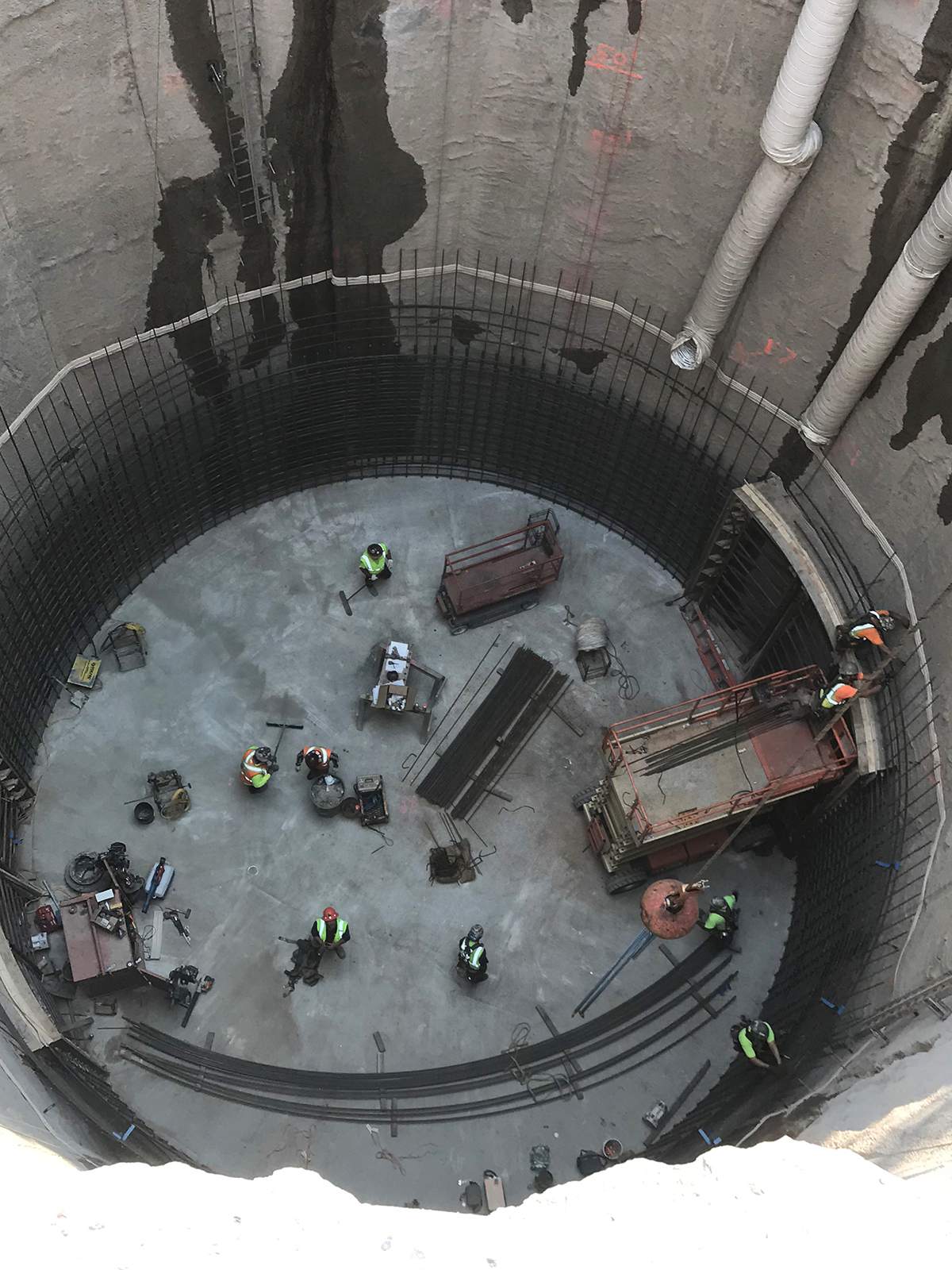
Hello down there! Crews recently poured the base concrete on the first of six storm water storage tanks on the west side of I-35W between 40th and 42nd streets in Minneapolis. Submitted photo. |
Where do you put millions of gallons of rain water in the middle of a dense urban environment?
You put it down. As in “underground.”
Crews recently poured the base concrete on the first of six storm water storage tanks on the west side of Interstate 35W between 40th and 42nd streets in Minneapolis. When they are finished, the tanks will reduce the flooding risk on the freeway by holding 4.56 million gallons of water, or the equivalent of seven Olympic-sized swimming pools.
During heavy rains, this section of I-35W can flood and be impassable. The new tanks will collect extra water and store it while the drainage system catches up. The collected water is then pumped back to the storm sewer pipe, which leads to the Mississippi River, when the pipes are able to handle the water again.
Excavation on the second storage tank has been recently completed. All six tanks will be connected by a tunnel, and work should finish by summer 2023.
The $72 million project is the first of its kind in Minnesota. Due to the density of the area around I-35W, use of a typical holding pond to collect runoff water during a heavy rain event isn’t an option.
“The storm tunnel under I-35W in this area is 12 feet in diameter, but is still undersized and pressurizes during heavy rains,” said Tim Nelson, project engineer. “When the tunnel pressurizes, it can cause flooding since that the low point in the road is between 40th and 42nd streets. So we’re basically building a holding pond, except that it is inside engineered structures in the ground. When this is finished, people won’t see a thing. Drivers on I-35W won’t even know it’s there. The main difference is that these tanks should help alleviate flooding for big rain events.”
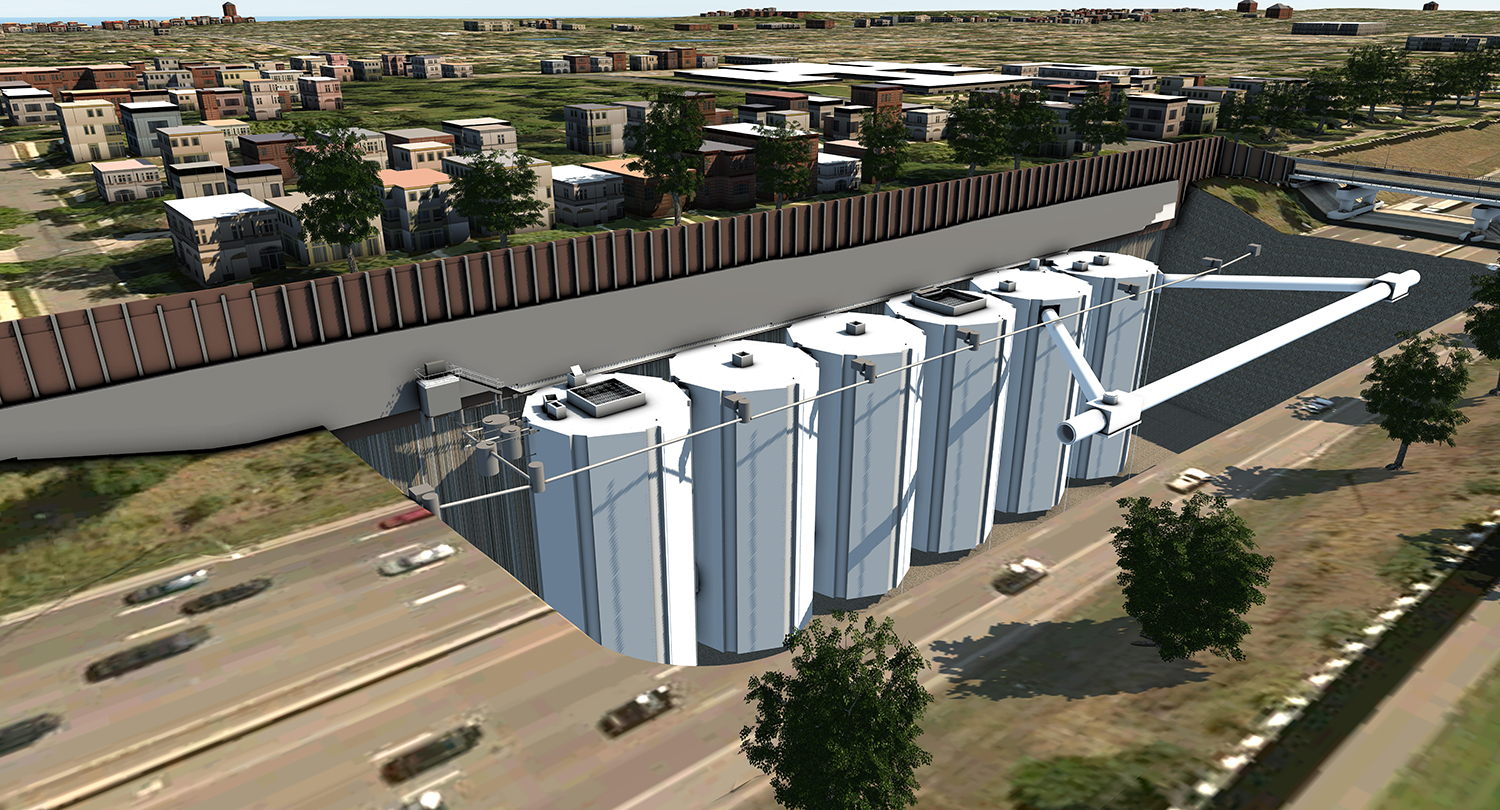
Illustration of the six holding tanks. Submitted photo. |
While the floodwater comes down in drops, the dirt from these holes comes up a few backhoe scoops at a time. These scoops are hauled up via a bucket/crane and then driven away in dump trucks. The estimated 36,000 cubic yards of soil excavated from the caverns will be used as fill elsewhere.
“Due to the nature of the project, space constraints are tight, with not a lot of working room for large equipment,” Nelson said.
Safety is always a priority.
“You’ve got people 100 feet down, with groundwater that wants to come in but is controlled by pumps,” he said. “If one of the pumps fails, it would basically turn into a mud pit. The area is outfitted with many sensors, and both the sensors and pumps are constantly monitored. We need ways for people to get out quickly if they have to. There are ladders bolted into the side of the wall, and a dedicated crane with a metal basket for getting people in and out. Weather is also a concern and is constantly monitored.”
Each tank will measure 42 feet in diameter by 90 feet deep on the inside, with 5.5-foot thick concrete walls. And while people passing by might eventually forget that it’s there, those who worked on it, like Nelson, won’t.
“I’ll remember how unique this is,” he said. “It’s the first of its kind in Minnesota, with construction techniques that MnDOT doesn’t typically see, like installing diaphragm walls 110 feet into the ground. It posed a lot of challenges with being deep underground, including the geological characteristics and the groundwater challenges.”
Learn more about the I-35W storm water storage tanks.
| |
|

|
 |
TABLE of CONTENTS
 |
Reducing Vehicle Miles Travelled could increase quality of life |
Climate change is impacting Minnesota, and transportation is the number one source of carbon pollution.
MnDOT has an opportunity to help people shift gears to reduce their contribution to human-caused climate change and lead through action.
In March, MnDOT supported a number of recommendations made by the external Sustainable Transportation Advisory Council, including agreeing to a preliminary goal to reduce vehicle miles traveled by 20 percent statewide and per capita by 2050. This is one of many strategies (like electric vehicles and chargers, low-carbon fuels, and promoting transit, biking and walking) recommended as part of an all-of-the-above approach to achieve state greenhouse gas reduction goals.
“We need multiple strategies to chart our course for a low-carbon transportation future,” said Commissioner Margaret Anderson Kelliher. “Increasing transportation options and reducing vehicle miles traveled are critical and provide a host of important co-benefits for our communities.”
Strategies to reduce carbon pollution from vehicles and fuels continue to be important, but don’t include the benefits from increasing transportation options and reducing VMT. These benefits include:
- Increased safety for people biking and walking
- More livable communities
- Less time spent in traffic and less money spent on transportation
- Potential reduction of disparities in a system that requires personal vehicle ownership to access jobs, education and other basic needs
“We recognize that multimodal options and broadband access are different in urban and rural communities, so a final VMT goal may reflect these different needs and opportunities,” said Tim Sexton, assistant commissioner and chief sustainability officer. “Ultimately, this is about giving all Minnesotans more choices to safely, affordably and reliably get around without compromising the health, economy and climate for future generations.”
MnDOT currently encourages consideration of multimodal accessibility and transportation options on all plans and projects. The agency will continue to apply existing approaches to planning and project development. No immediate changes are required until a final VMT goal is established and new tools and guidance are developed.
Plans call for finalization of a VMT reduction goal in early 2022 through partner coordination, internal workgroup efforts and Statewide Multimodal Transportation Plan engagement. Guidance for how the goal will apply to MnDOT projects will be developed along with the final goal.
Employees are encouraged to stay informed through the Sustainability iHUB webpage. Progress towards the VMT reduction goal will be reported annually through the MnDOT Sustainability Report and the Minnesota.
|
| |
|

|
 |
TABLE of CONTENTS
 |
Ceremony to mark 20th anniversary of 9/11, honor those who have served since |
MnDOT Newsline looks back at 9/11
Most people can recall precisely where they were, who they were with and what they were doing when major historical events occurred, like JFK’s assassination, the Challenger explosion, the Halloween Blizzard, and Columbine (and other school shootings), to name a few. These events, whether natural or manmade, have become imprinted in our memory, forever serving as a milepost for life “before” and life “after.”
The events of Sept. 11, 2001 are no exception, whether you were still a toddler or in a school room or in the workforce at the time. For many current MnDOT employees, we were at our desks or on the road doing what we would normally be doing on a sunny Tuesday morning in September. Here’s how MnDOT Newsline covered the event in the days and weeks following the terrorist attacks:
|
The Minnesota Department of Veterans Affairs, the 9/11 and Global War on Terrorism Remembrance Task Force, and the Minnesota Military and Veterans Museum will mark the 20th anniversary of 9/11 with a day of remembrance event on the Minnesota State Capitol grounds starting at 9 a.m. Saturday, Sept. 11.
In addition to memorializing the events of that day and honoring those impacted, this event is focused on honoring the more than 40,000 Minnesota veterans who have served in the Global War on Terrorism during the last 20 years.
The event will feature participation in the national Tolling of the Bells and a reading of names of those killed on 9/11 and in action during the Global War on Terrorism. The commemorative ceremony will include aircraft flyovers, guest speakers, musical performances and military honors. Speakers include Gov. Tim Walz; Joseph Votel, retired U.S. Army general; Larry Herke, MDVA commissioner; Jill Stephenson, Gold Star mother; and Mariah Jacobson, daughter of Flight 93 hero Tom Burnett.
Other elements of the day include a documentary screening of “Resolute: MN Stories of 9/11 & the War” and museum displays, veteran support and discussions groups, live music, food vendors, connection opportunities, children’s activities and more.
Check the MDVA events page for more information and detailed event schedules.
*Event will follow current COVID-19 prevention guidelines set by the Minnesota Department of Health and the CDC.
|
| |
|

|
 |
TABLE of CONTENTS
 |
District 6 mechanic earns Above and Beyond award for rescuing motorcyclist after crash |
By Joseph Palmersheim
The motorcycle was in the guard rail.
Not by it. Not near it. In it.
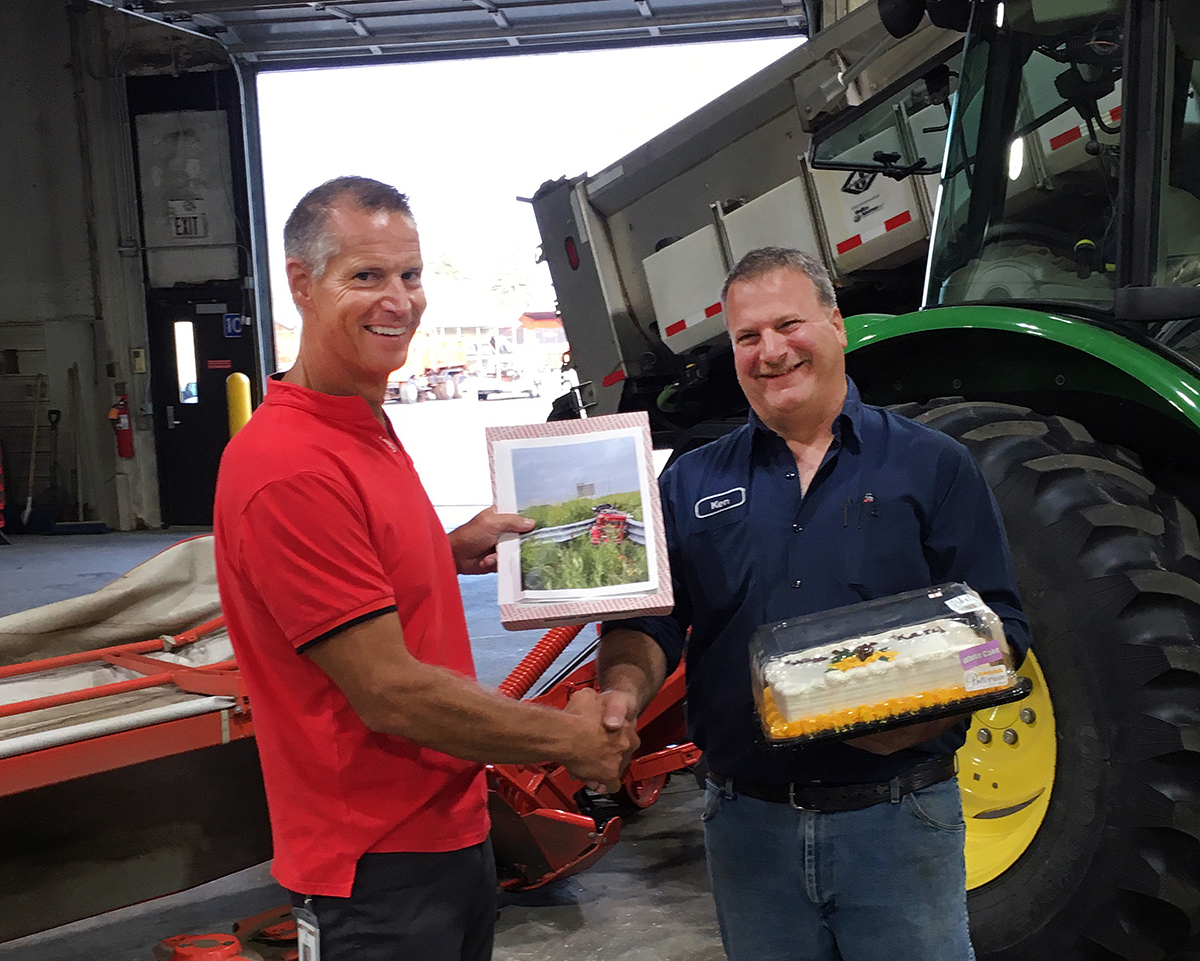
Mark Panek, assistant director of engineering for District 6 West Operations, presented Ken Benson with an Above and Beyond Award on Aug. 4 in recognition of rescuing an injured motorcyclist on July 9. Photo by Ron Seifert. |
And when Ken Benson drove by the scene on Interstate 90 halfway between Austin and Albert Lea on July 9, the mobile equipment mechanic based in District 6’s West Equipment Shop could tell something was seriously amiss.
“We don’t leave smashed equipment on the highway after an accident,” the five-year MnDOT employee and former truck driver said.
What Benson did next likely saved a man’s life, and earned him an Above and Beyond Award for Excellence in Heroism and Public Service.
After turning around and stopping, Benson, an experienced Harley-Davidson rider, noted that the motorcycle’s engine wasn’t hot, meaning that the crashed bike had been there for a while.
But if the bike was here, where was the rider?
“I looked around in the bushes, and I saw him about 30 feet away,” Benson recalled. “I called out, ‘Is anyone in there?’ and didn’t get a response, so I assumed the worst. I called 911, and he started yelling for help.”
Benson made his way through the brush and did his best to keep the injured man comfortable.
“It certainly wasn’t a sight you wanted to see,” he said. “I asked him his name, and told him that he was in tough shape but that he’d be OK.”
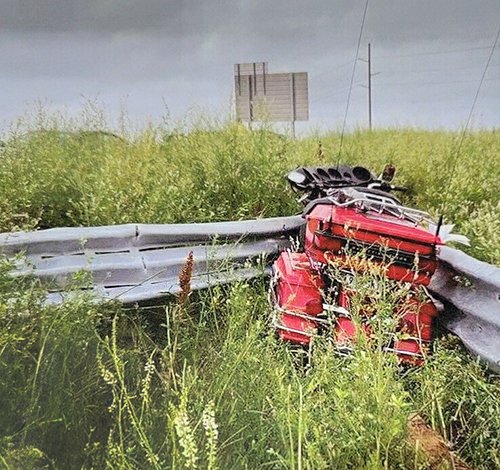
Ken Benson saw this motorcycle in the guard rail between Austin and Albert Lea on I-90 July 9. Photo by Minnesota State Patrol. |
A paramedic team arrived after “the longest five minutes” of Benson’s life. He helped the team move the injured man onto a gurney, which was then loaded onto a medical helicopter. When the noise from the medevac’s rotor blades faded into the distance, Benson was left to ponder what had just happened.
“My heart was racing so bad it was unbelievable,” he said. “I’m glad I found him, because everyone was just driving by. He told me that a car ran him off the road. I’m glad I saw him, because I wasn’t sure how long he’d been sitting there. I bet he was there an hour. Thank God the grass was tall, because it busted his fall.”
The man survived, though Benson notes that it may be some time before he can walk again.
Mark Panek, assistant director of engineering for District 6 West Operations, presented Benson with his award on Aug. 4 in front of the mechanics at the station.
“I was kinda happy when I found out about the award,” Benson said. “I thought it was cool.”
But there’s a serious side to it, too.
“That’s not the first time I’ve seen something bad, and it won’t be the last,” he said. “You wish this kind of thing didn’t happen to anyone.”
|
| |
|

|
 |
TABLE of CONTENTS
 |
Offices collaborate on transportation-themed summer camps |
By Su Love, Office of Civil Rights
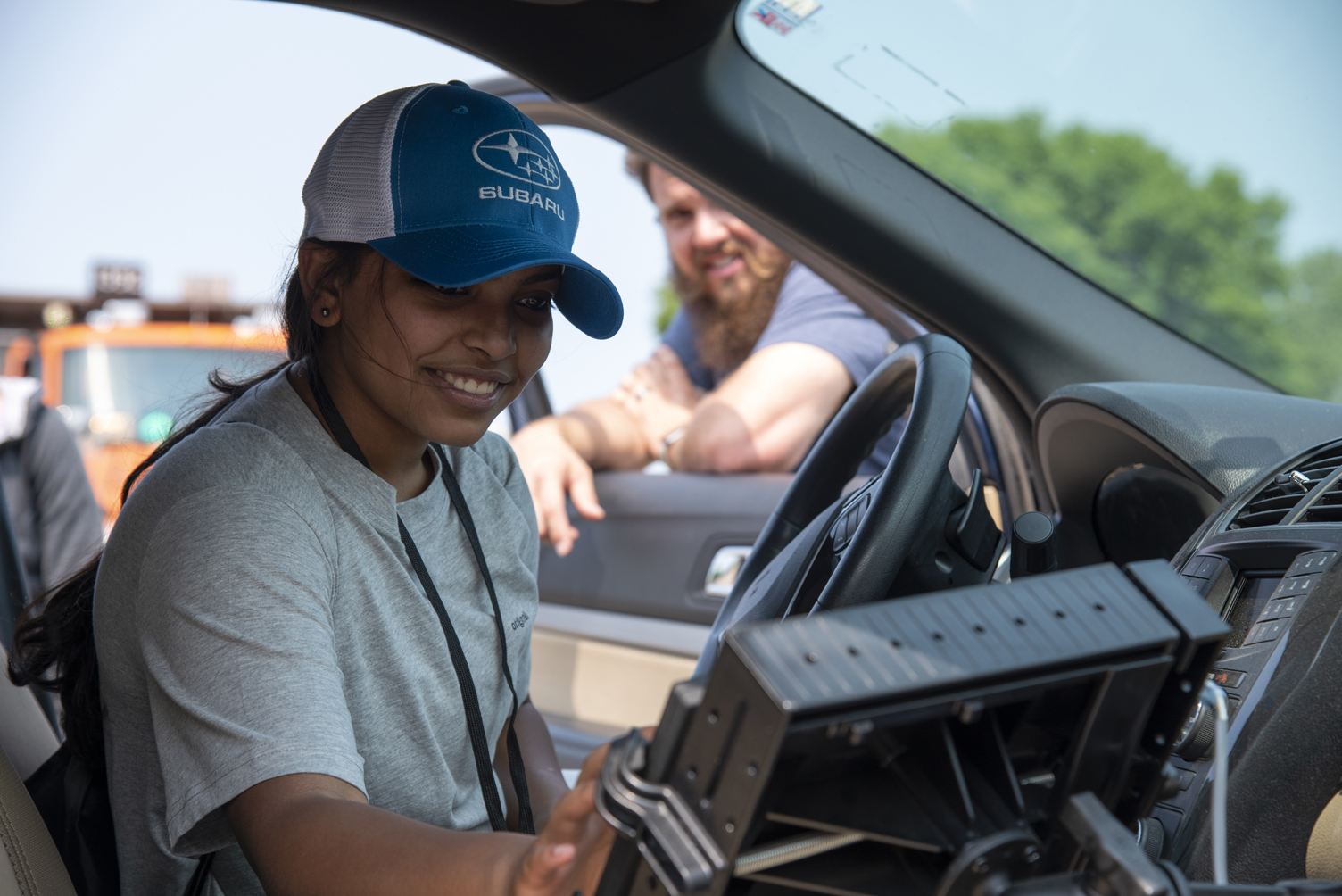
MnDOT Road Weather Technology Coordinator Alex Bruch demonstrates maintenance equipment to a CAV Career Pathways Camp participant. Photo by Michael McCarthy. |
Several MnDOT offices recently teamed with the Office of Civil Rights on two summer camps (a Connected and Automated Vehicles Camp and the National Summer Transportation Institute) meant to introduce students in grades 7-12 to a wide range of transportation career opportunities.
MnDOT experts in Aeronautics, Bridge, Connected and Automated Vehicles, Maintenance, MnROAD, Project Management and Technical Support, and STEM Education and Outreach contributed. MnDOT partnered with the Minnesota Pollution Control Agency, the University of Minnesota, ITS Minnesota, architectural and engineering firms, the Minnesota Technology Center of Excellence and local businesses to show the wide range of career opportunities for participating youth.
The Connected and Automated Vehicle Career Pathways Camp, for students entering grades 9-12, took place Aug. 9-13 at White Bear Lake High School, with field trips around the Twin Cities metro area. Students watched a farmer demonstrate automated technology in the milking industry and discussed translating innovation in agriculture to transportation. Other activities included learning about sensor technologies that create the vehicles and testing out autonomous shuttles. Kristin White, executive director of CAV-X, led scenario planning exercises in which students assessed and presented benefits and risks of automation, connectivity, electrification and shared mobility for 2041.
Students in both camps experienced road maintenance equipment demos.
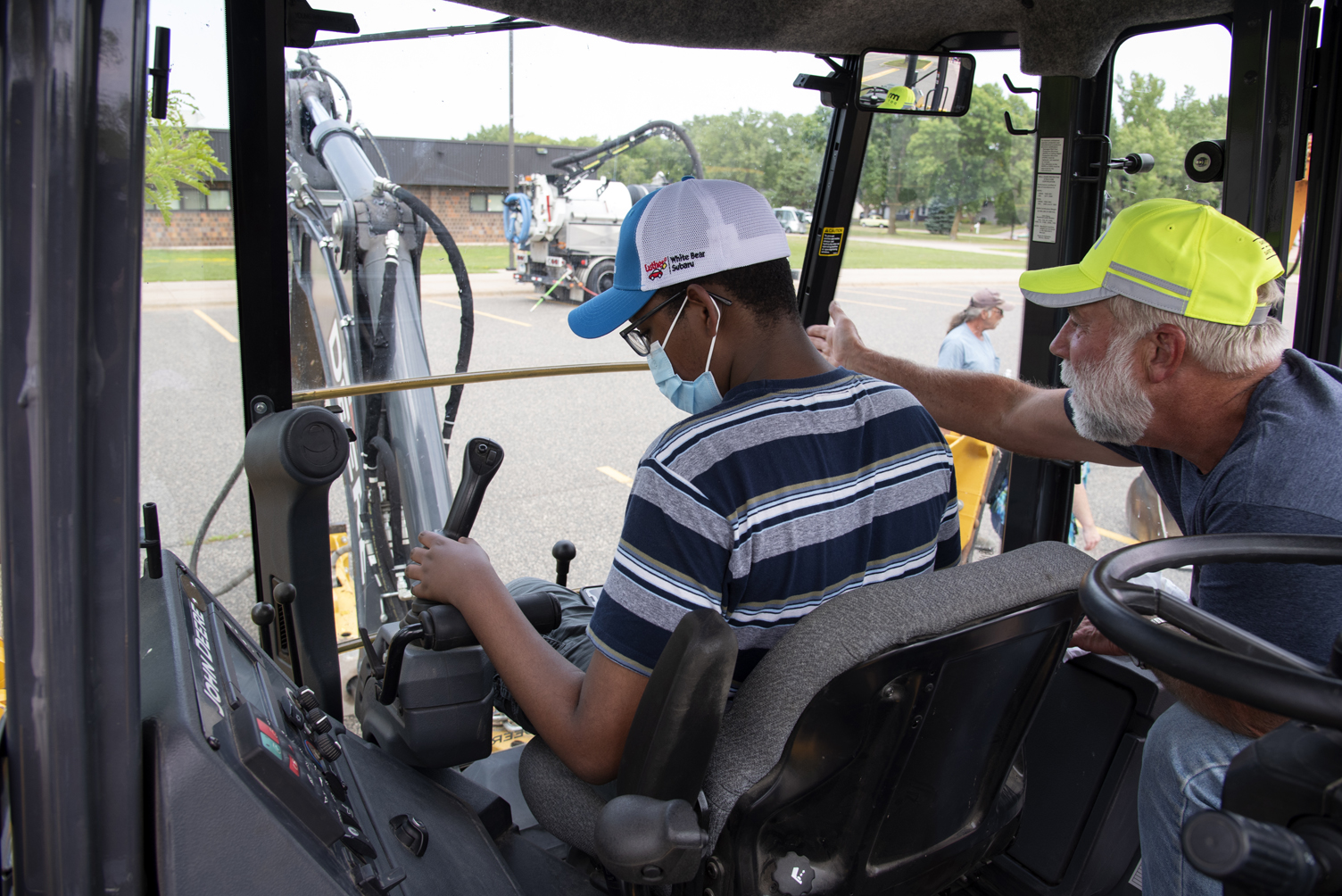
MnDOT Technology Coordinator Scott Deutsch explains how to operate maintenance equipment to a CAV Career Pathways Camp participant. Photo by Michael McCarthy. |
“It was great to see my MnDOT co-workers having such a good time explaining the equipment, being so enthusiastic,” said Alex Bruch, road weather technology coordinator. “The students were very engaged and asked a lot of good questions.”
The National Summer Transportation Institute, for students entering grades 7-9, met online July 26-29. Participants received kits in the mail with materials for projects and went on virtual tours. MnROAD Operations Engineer Ben Worel explained how asphalt plants work and demonstrated road design and construction. Everyone made “asphalt road cookies” in their homes with walnuts for coarse aggregate, oats for fine aggregate, coconut as mineral filler and chocolate as asphalt binder, rolled out for density.
NSTI Camp participants also built lift bridges using Popsicle sticks and syringes. Before choosing their model, students learned from MnDOT bridge engineers Brandon Day and Julie Johnson about several bridge constructions and advantages of each.
“NSTI Camp is a great opportunity for tomorrow’s engineers to interact with today’s engineers,” Day said. “Every year I am impressed that these kids choose to participate in an extracurricular activity that requires them to think and to problem-solve, and it is always a smart group of kids. It feels good to give them a hand on their path through life.”
“The enthusiasm, energy and creativity the students brought to the program and bridge-building was very inspiring to me,” Johnson said.
|
| |
|
| |
|



